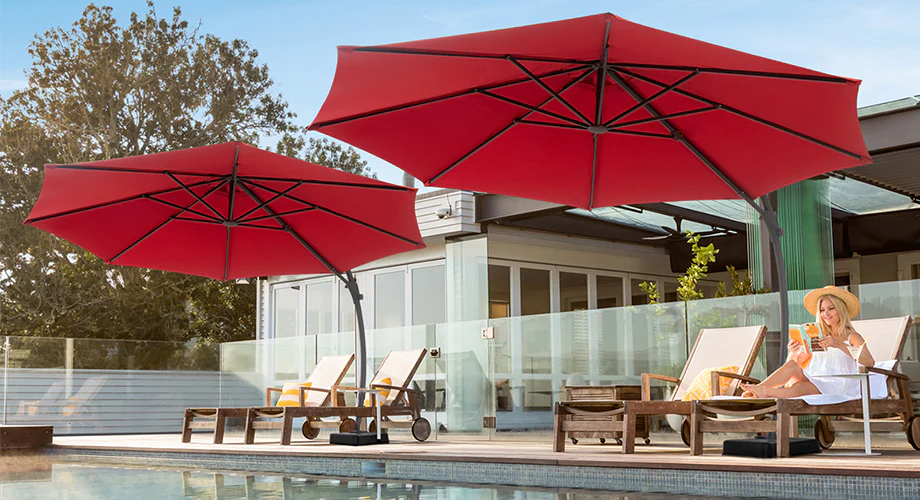What is a Patio Umbrella?
A patio umbrella is an outdoor accessory that can transform any outdoor space into a comfortable and shaded area. Its design typically includes a canopy fabric that is supported by a pole in the center. The canopy can come in various shapes and materials, including polyester, acrylic, and vinyl that provide shelter from the sun, wind, and rain. The pole can be made of wood or metal, and it may also have adjustable features that allow its height to be customized to fit specific needs.
Patio umbrellas are typically used on patios, decks, and balconies to provide protection from the sun while enjoying time in the outdoors. When not in use, the umbrella can be closed and stored away with ease. They can be freestanding or attached to a table, and there are also cantilever umbrellas that are positioned off to the side with a weighted base.
Regular maintenance is necessary to keep the patio umbrella in good condition. Cleaning the canopy regularly is vital to remove dirt, mildew, and bird droppings that can damage the material. The patio umbrella pole needs to be washed and dried before storing it away to prevent rust buildup.
One of the biggest enemies of patio umbrellas is wind. Strong gusts can cause the umbrella to tip over, leading to damage to the umbrella, furniture, or even people in the vicinity. Choosing an umbrella with a heavier base can help with stability. It is also recommended to close the umbrella when not in use or in inclement weather.
In some cases, patio umbrellas can sustain damage due to mishaps, wear and tear, or weathering. However, with cost-effective repairs available, there is no need to replace the entire umbrella. Some common repairs include fixing tears in the fabric, replacing the broken cord or ribs, and regluing loose parts.
Overall, a patio umbrella is a versatile and functional accessory that can enhance any outdoor space. With proper maintenance and timely repairs, a patio umbrella can provide years of shade and weather protection.
Benefits of Patio Umbrellas
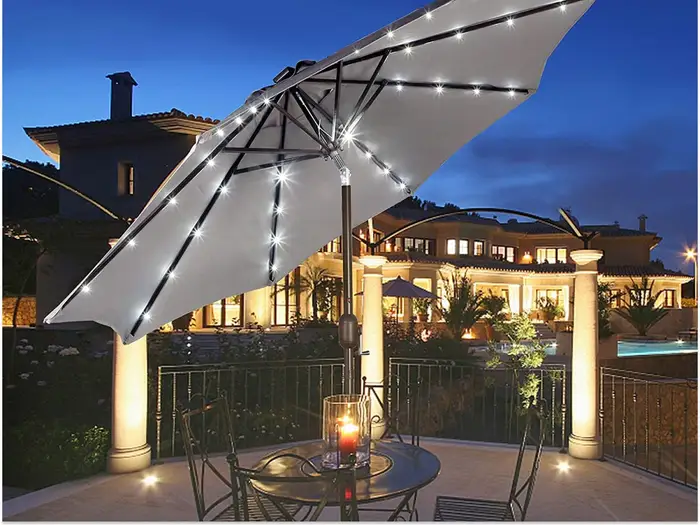
Patio umbrellas are a popular addition to any outdoor space, offering both practical benefits and aesthetic appeal. Here are some of the key benefits of using patio umbrellas:
1. Protection from the sun: Perhaps the most significant benefit of patio umbrellas is the protection they provide from the sun. Spending time in the sun can be enjoyable, but it can also be dangerous in terms of UV exposure. Patio umbrellas offer a shaded area where you can relax and enjoy the outdoors without worrying about harmful rays.
2. Increased comfort: By providing a shaded area, patio umbrellas can help make spending time outdoors more comfortable. This is particularly true in areas with high temperatures, where the shade provided by an umbrella can make a significant difference.
3. Versatility: Patio umbrellas come in a variety of sizes, styles, and colors, making them a versatile addition to any outdoor area. They can be used as standalone features in a garden or deck or as part of a larger seating area around a table or pool. Moreover, cantilever umbrellas offer a 360-degree rotation for optimal shade protection.
4. Aesthetic appeal: Patio umbrellas are available in a range of designs, from classic to modern, and can enhance the aesthetic appeal of any outdoor space. Choosing a patio umbrella that matches your existing décor can help create a cohesive look while adding an element of style to your outdoor area.
5. Cost-effective: Investing in patio umbrellas is a cost-effective way to enhance your outdoor space. While building a permanent structure such as a pergola or gazebo can be expensive, patio umbrellas are a more affordable option that still provides a similar level of shade and protection.
In conclusion, whether you’re looking to create a comfortable outdoor space for entertaining or simply want to protect yourself from the sun, patio umbrellas are an excellent choice. With their versatility, aesthetic appeal, and practical benefits, these umbrellas can help you make the most of your outdoor area.
Types of Patio Umbrellas
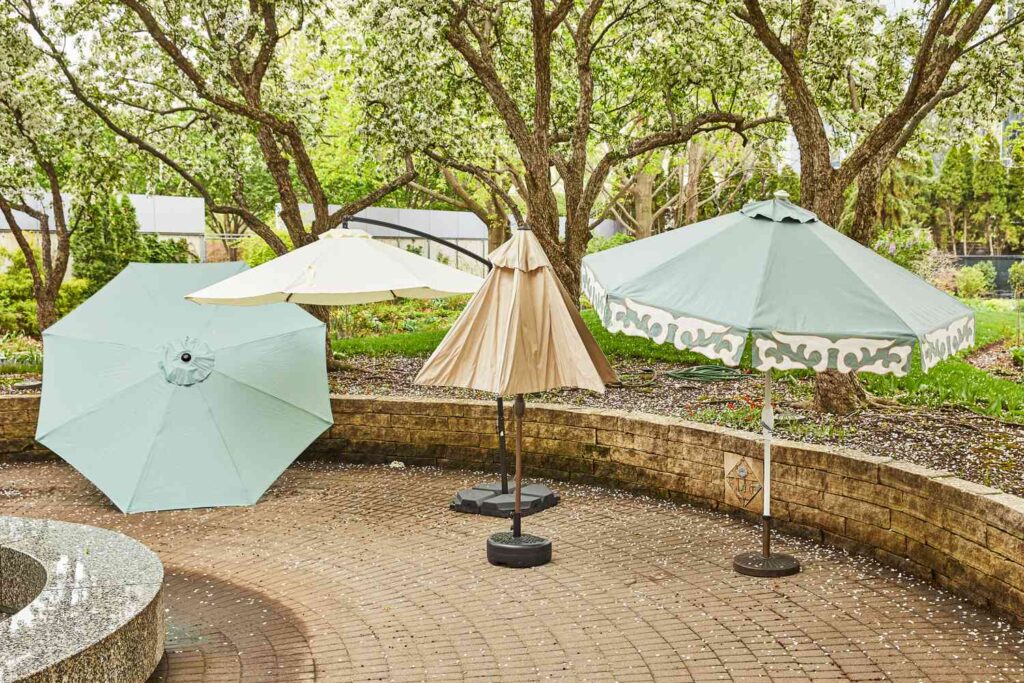
When it comes to patio umbrellas, there is a wide range of options to choose from. Different types of patio umbrellas have unique features and designs that can suit different preferences and needs. Here are some of the most popular types of patio umbrellas:
1. Traditional Umbrellas: These are the most common type of patio umbrellas that come with a central pole to support the canopy. Traditional umbrellas are available in a variety of sizes and shapes, including round, square, and rectangular. They are designed to provide shade over tables and chairs and feature a vented canopy to allow airflow.
2. Cantilever Umbrellas: Unlike traditional umbrellas, cantilever umbrellas come with an offset pole that allows the canopy to hang over the table without getting in the way. This design creates more space beneath the umbrella and provides more shade with 360-degree rotation capabilities. Cantilever umbrellas are available in different sizes and shapes to suit different areas.
3. Free-standing Umbrellas: These are patio umbrellas that are not affixed to any structure or table. They come with a stable base instead of a central pole and they can be moved around easily. The base is usually weighted to ensure the umbrella remains stable even in windy conditions.
4. Umbrellas with lights: These types of patio umbrellas come with built-in LED lights that provide illumination at night. They are perfect for outdoor dining areas and patios where there is insufficient lighting. Some models come with adjustable brightness levels and can be dimmed to create a cozy ambience.
5. Solar-powered Umbrellas: These types of umbrellas feature solar panels that charge during the day and provide power to LED lights and other accessories at night. This eco-friendly option doesn’t require any electricity, making it a great choice for those who want to save on energy bills and reduce their carbon footprint.
6. Double-sided Umbrellas: Dubbed the Phi Villa 15ft patio umbrella, double-sided patio umbrellas feature two canopies that provide shade on both sides. They are ideal for large outdoor spaces and can cover a wide area without sacrificing style. They come in a variety of colors and designs, and some models feature a crank that makes it easy to open and close.
In conclusion, patio umbrellas are versatile and functional outdoor accessories that can provide shade, enhance aesthetics, and create a comfortable outdoor living space. With the wide range of types of patio umbrellas available in the market to choose from, homeowners can find the perfect umbrella that suits their style and needs.
Cantilever Umbrellas
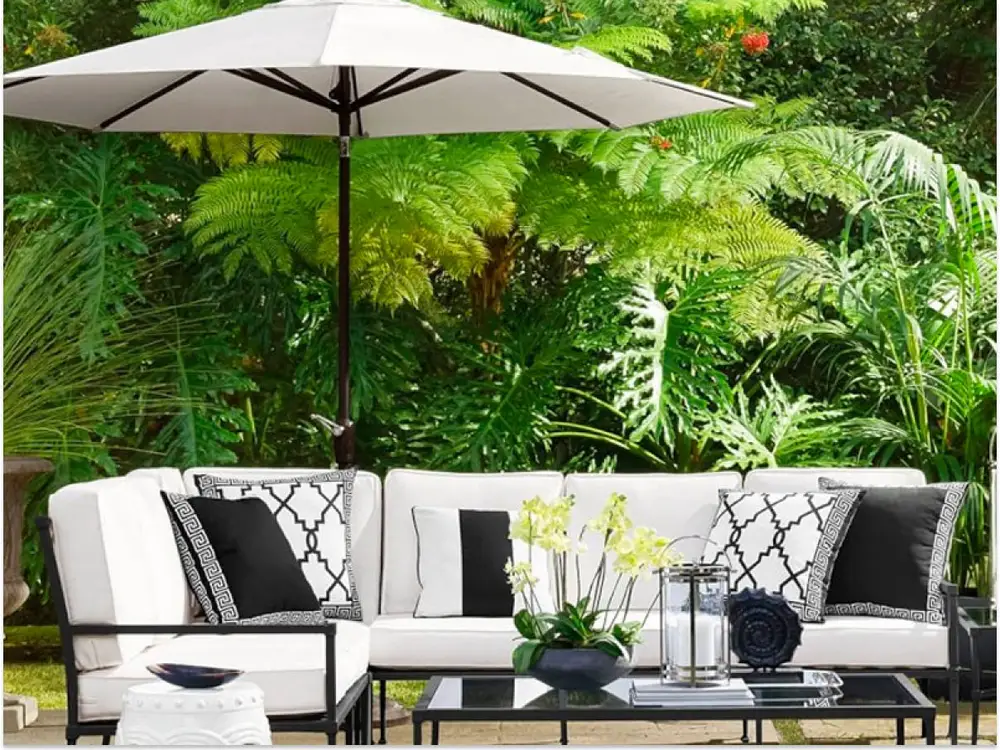
Cantilever umbrellas have become increasingly popular among homeowners who are looking for an alternative to traditional patio umbrellas. These umbrellas feature an offset pole that allows the canopy to be suspended over an area without the need for a central support pole. This design creates a more open and airy atmosphere, providing a greater sense of space and freedom of movement.
One of the main advantages of cantilever umbrellas is their 360-degree rotation capabilities. This allows you to move the umbrella to any direction to block the sun and provide shade over any area you desire. Depending on the location and the time of day, you can adjust the angle to maximize your comfort.
Cantilever umbrellas come in a variety of shapes and sizes to suit any outdoor space. Some models are square, while others are rectangular or circular, giving you many options to choose from. They also come in different colors and fabrics, so you can easily find one that complements your patio or outdoor décor.
Another benefit of cantilever umbrellas is their durability and stability. The offset pole and stable base give the umbrella more stability and prevent it from falling over or being blown away in windy conditions. They are also designed to be water-resistant, making them ideal for outdoor use during rainy weather.
If you’re looking for a cantilever umbrella, it’s important to consider the quality of the materials used in its construction. A good-quality umbrella will last longer and provide better value for your money. When choosing an umbrella, look for features such as adjustable height, tilt mechanism, and a conveniently located crank handle for easy opening and closing.
In conclusion, cantilever umbrellas are an excellent choice for those who want to enjoy the outdoors while staying protected from the sun and rain. Their unique design and flexibility make them ideal for any outdoor space, providing comfortable shade and a touch of style and elegance to your patio or backyard. With the proper care and maintenance, your cantilever umbrella can offer years of satisfaction and enjoyment.
Free-Standing Umbrellas
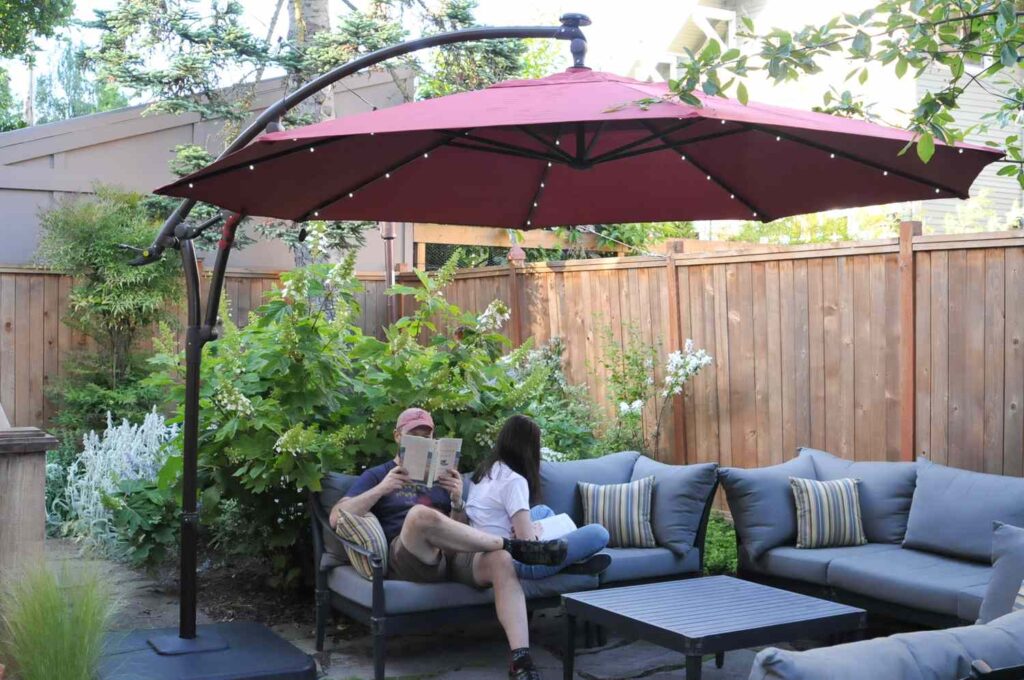
If you’re looking for a stylish and functional way to add shade to your outdoor space, look no further than free-standing umbrellas. These versatile umbrellas can be moved to any location, making them a great choice for patios, decks, and even pool areas.
One of the main benefits of free-standing umbrellas is their flexibility. Unlike table umbrellas or cantilever umbrellas, these umbrellas don’t require a fixed base or support. Instead, they come with their own base that can be filled with water or sand for added stability.
Free-standing umbrellas come in a variety of sizes and styles to suit any outdoor space. Some models are large enough to cover multiple seating areas, while others are more compact for smaller spaces. They also come in a range of colors and materials, so you can easily find one that complements your outdoor décor.
Another advantage of free-standing umbrellas is their ease of use. They typically come with a crank handle that makes opening and closing the umbrella a breeze. Some models also have a tilt mechanism that allows you to adjust the angle of the umbrella to block the sun at different times of the day.
While free-standing umbrellas are designed to be durable and long-lasting, they may occasionally require repairs. Common issues include broken poles, tears in the canopy fabric, or loose threads. Luckily, many of these problems can be easily fixed with basic tools and materials such as wood glue or fabric glue.
In some cases, it may be more cost-effective to hire an outdoor umbrella repair service to fix more complex issues. However, with regular maintenance and care, your free-standing umbrella should provide shade and comfort for years to come.
In conclusion, free-standing umbrellas offer a convenient and stylish way to add shade to your outdoor space. With a range of sizes, styles, and materials to choose from, you can easily find one that meets your needs and complements your outdoor décor. And with regular maintenance and repairs, your free-standing umbrella will continue to provide shade and comfort for many seasons to come.
Table Umbrellas
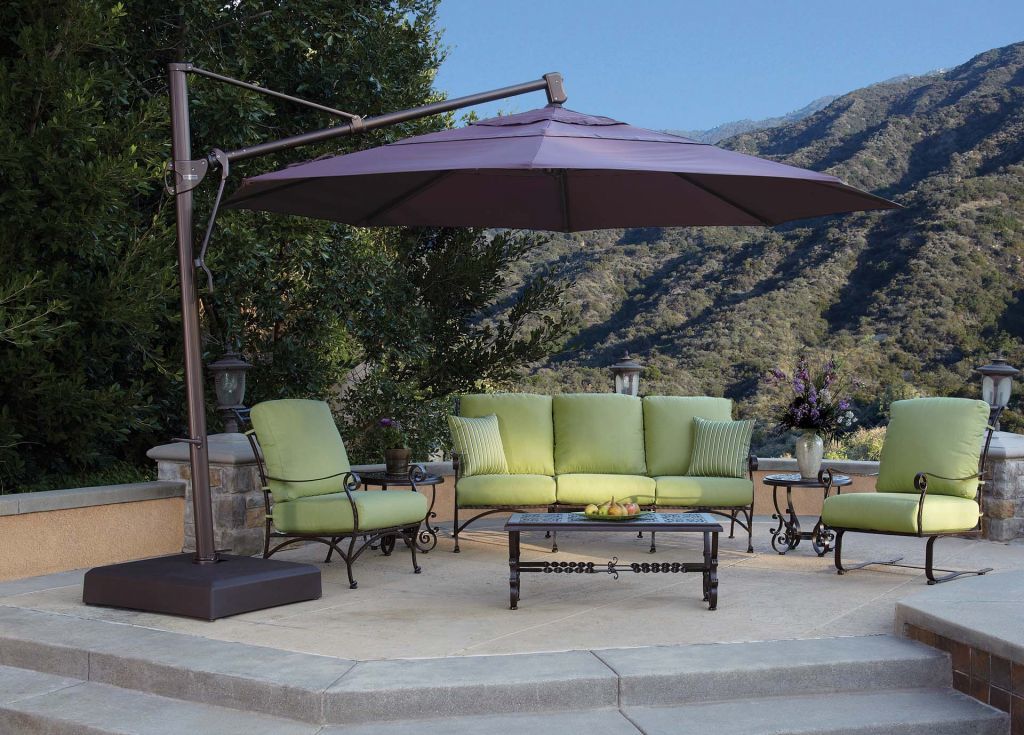
Table umbrellas are an essential component of any outdoor dining set. They not only provide shade and protection from the sun’s harmful UV rays, but they also add a touch of style and elegance to your outdoor space. These umbrellas come in various materials, sizes, and shapes to suit your specific needs and preferences.
One of the most important factors to consider when choosing a table umbrella is the size of your outdoor table. The umbrella should be proportionate to the table so that it provides sufficient shade without overwhelming the space. Table umbrellas come in various sizes, ranging from small 6-foot ones to large 10-foot ones, and you will need to choose the right size for your table.
Another important factor to consider when choosing a table umbrella is the material it’s made of. Most table umbrellas are made from water-resistant and UV-resistant fabrics such as polyester, acrylic, or olefin. These materials are durable and can withstand harsh outdoor conditions. However, if you want something even more durable, you can opt for a table umbrella made from Sunbrella fabric, which is known for its resistance to fading, stains, and mildew.
Table umbrellas also come in various shapes, including round, square, and rectangular. The shape you choose will depend on your personal taste and the shape of your outdoor table. Round umbrellas are ideal for circular tables, while square and rectangular umbrellas complement square and rectangular tables, respectively.
In terms of operation, table umbrellas can be either manual or automatic. Manual umbrellas require you to crank them up and down manually, while automatic umbrellas have a motor that does the job for you. Automatic umbrellas are more convenient to use, but they’re also more expensive than manual ones.
Like any outdoor furniture, table umbrellas require regular maintenance to ensure their longevity. You should clean the umbrella fabric regularly to prevent dirt and grime buildup, and store the umbrella in a dry place during the off-season.
In conclusion, table umbrellas are a must-have for any outdoor dining set. They provide shade, protection, and style, and come in a variety of sizes, materials, and shapes. Choose the right one for your table, and don’t forget to take good care of it to ensure its longevity.
Common Damage to Patio Umbrellas

Patio umbrellas are a great addition to any outdoor space, providing shade and protection from the sun. However, they are not immune to damage and wear and tear. Here are some common types of damage that patio umbrellas experience:
1. Broken Ribs
The ribs of a patio umbrella are the supports that hold up the canopy. They can become damaged or broken from strong winds, being bumped into, or accidentally stepping on them. Broken ribs can cause the canopy to sag or become misshapen, and can also make it difficult to open and close the umbrella.
2. Torn Canopy
The canopy of a patio umbrella is made from fabric, which can tear or become damaged from exposure to the elements. This is especially common in areas with high winds or harsh weather conditions. Torn canopies can let in sunlight and rain, defeating the purpose of the umbrella.
3. Broken Cord or Pulley
The cord or pulley system in a patio umbrella is what allows it to be opened and closed. Over time, these parts can become worn or damaged, making it difficult or impossible to open or close the umbrella. This can be frustrating and render the umbrella unusable.
4. Broken Pole
The pole of a patio umbrella is what holds it upright and provides support. It can become broken or damaged from being knocked over, strong winds, or general wear and tear. A broken pole can make the umbrella unstable or unusable.
5. Loose Threads or Seams
The seams and threads in the canopy of a patio umbrella can become loose or start to fray over time. This can weaken the fabric and make it more susceptible to tearing or further damage. It can also make the umbrella look worn and unattractive.
In conclusion, while patio umbrellas are a great addition to any outdoor space, they can experience damage and wear and tear. Regular maintenance and care can help prevent damage and prolong the life of your umbrella. However, if you do experience damage, there are repair options available. Some repairs can be done at home, while others may require professional help.
Loose Threads and Tears in Fabric
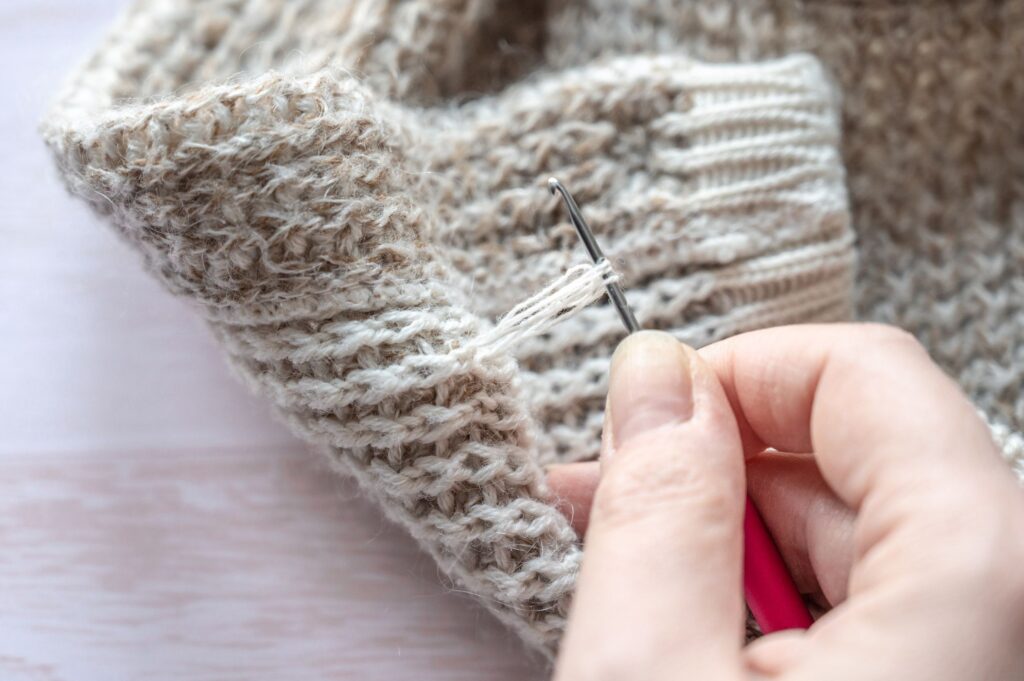
When it comes to patio umbrellas, it’s not uncommon for the fabric to become damaged over time. Whether it’s due to exposure to the elements, accidents, or just regular wear and tear, loose threads and tears in the fabric can be frustrating and unsightly.
Loose threads and seams can weaken the fabric and make it more susceptible to further damage. If left untreated, loose threads can start to unravel and make the tear larger. This can cause the canopy to sag or become misshapen, which can significantly reduce its effectiveness in providing shade.
Tears in the fabric can be even more problematic. They can let in sunlight and rain, defeating the purpose of having a patio umbrella in the first place. If the tear is large enough, it can render the umbrella unusable altogether.
Fortunately, there are a few ways to repair loose threads and tears in a patio umbrella fabric. One option is to use fabric glue or wood glue to seal the damaged area. These types of glue can help to prevent further damage and strengthen the fabric.
Another option is to use a patch to cover the tear. Nylon or other self-adhesive patches can be used to cover the damaged area and provide added protection. These patches are waterproof and can withstand exposure to the elements, which makes them a great option for repairing patio umbrellas.
If you’re not comfortable repairing the umbrella yourself, there are outdoor umbrella repair services that can do it for you. These professionals have experience working with patio umbrellas and can provide cost-effective repairs that will restore your umbrella to good-as-new condition.
Regular maintenance is also key to preventing loose threads and tears from forming in the first place. This includes keeping the umbrella clean, storing it properly, and ensuring that it’s not subject to excessive wind or other mishaps.
Overall, loose threads and tears in patio umbrella fabric are a common problem, but they don’t have to be a source of frustration. With the right tools and techniques, you can repair your umbrella and enjoy your outdoor space once again.
Broken Pole or Cord
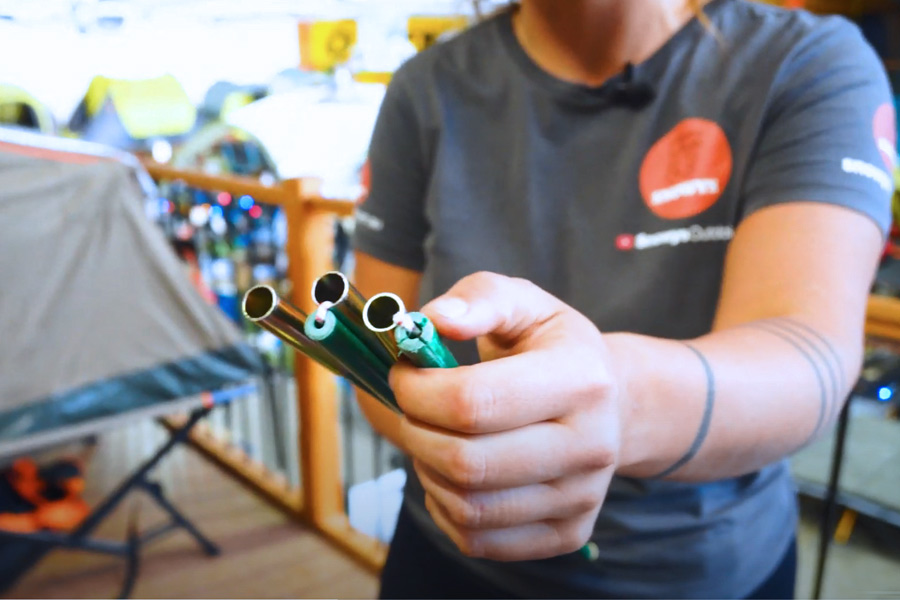
Patio umbrellas are a great way to enjoy the outdoors and protect yourself from the sun’s harmful rays. They offer shade and comfort, allowing you to spend more time outside. However, like any outdoor furniture, patio umbrellas can suffer from wear and tear over time. One of the most common issues with patio umbrellas is a broken pole or cord.
A broken pole can occur due to a variety of factors, such as harsh weather conditions, excessive wind, or simply old age. When a pole breaks, it can render the entire umbrella unusable. Depending on the extent of the damage, the umbrella may need to be replaced entirely.
If the pole is only partially broken, it may be possible to repair it using wood glue or epoxy. However, this method may not be effective if the break is near the top of the pole, where it bears the weight of the umbrella. In this case, it’s best to replace the entire pole to ensure the umbrella is safe and stable.
A broken cord is another common issue with patio umbrellas. The cord is what holds the canopy in place and allows you to open and close the umbrella. If the cord breaks, the umbrella will no longer open or close, making it difficult to use.
Fixing a broken cord is relatively easy and can be done at home. First, remove the old cord and measure it to determine the length of the new cord needed. Then, thread the new cord through the pulley system and tie a knot at the end. Finally, attach the cord to the canopy using a cord lock or knot.
In some cases, you may need to replace the entire pulley system if it’s damaged or worn out. This can be done by purchasing a replacement kit and following the instructions provided.
In conclusion, a broken pole or cord can be a minor setback for your patio umbrella, but with some know-how, it can be fixed. Consider repairing the items at home using wood glue or replacing the entire pole if necessary. For a broken cord, measure the length of the new cord and install it through the pulley system. Remember to always practice proper maintenance on your patio umbrella to extend its lifespan.
Other Types of Damage
Aside from broken poles and cords, patio umbrellas can sustain various types of damage that can be repaired. One of the most common types of damage is tears in the umbrella fabric. This can occur due to heavy winds or accidental punctures, which can leave unsightly holes or loose threads. Fortunately, fabric glue can be used to fix these issues.
To repair a tear in the fabric, first, clean the affected area and make sure it’s dry. Then, apply a small amount of fabric glue to the tear, making sure to spread it evenly. Allow the glue to dry completely before using the umbrella again. If the tear is too large or extensive, a professional repair service may be necessary.
Another type of damage that patio umbrellas can sustain is broken ribs. The ribs are the rods that give the umbrella its shape and support the fabric canopy. If one or more ribs are broken, the umbrella may not function properly or may not open at all. In this case, replacing the broken rib or ribs is necessary.
Fortunately, replacement ribs can be purchased online or at home improvement stores. To replace a broken rib, first, remove the old one by cutting the fabric and unscrewing the rib from the central hub. Then, install the new rib by reversing the process. Make sure to adjust the tension of the fabric on the rib before reattaching it to the hub.
Finally, it’s worth noting that regular maintenance can help prevent damage to patio umbrellas. One of the best ways to prevent damage is by using a heavier base with free-standing or table umbrellas. This can help keep them stable during windy conditions. Additionally, rotating cantilever umbrellas 360-degree can help prevent wear and tear on one particular spot.
In conclusion, patio umbrellas can sustain various types of damage, but many can be repaired with the right tools and materials. Whether you’re dealing with a torn fabric, a broken rib, or a malfunctioning pulley system, there are ways to get your patio umbrella back in working order. With regular maintenance, you can help prevent damage and prolong the life of your outdoor umbrella.
Repairing a Patio Umbrella Yourself

Patio umbrellas can add a touch of elegance and functionality to any outdoor space. Not only do they provide shade and protection from the sun, but they can also make your patio or deck area more comfortable and enjoyable. Unfortunately, like any outdoor product, patio umbrellas are subject to wear and tear and may require repairs from time to time.
The good news is that repairing a patio umbrella yourself can be a simple and cost-effective solution. With just a few tools and materials, you can save money and extend the life of your favorite piece of outdoor furniture.
The first step in repairing a patio umbrella is determining the type of damage. Loose threads, a broken cord, or a tear in the fabric can often be fixed with fabric glue or a simple patch. For fabric repairs, it’s essential to make sure the area is clean and dry before applying any adhesive. If the tear is too large or extensive, it may be best to seek professional help.
If you’re dealing with a broken umbrella pole or ribs, replacement parts can be found online or at home improvement stores. To replace a broken rib, you will need to remove the old one by cutting the fabric and unscrewing the rib from the central hub. Then, install the new rib by reversing the process. It’s important to make sure the fabric is properly tensioned before reattaching the rib to the hub.
For a broken umbrella pole, you will need to remove the upper piece of the pole from the lower piece by unscrewing the nut that connects them. Once you have the two pieces separated, you can either replace the damaged section or repair it with wood glue and clamps. Allow the glue to dry completely before reassembling the pole.
Regular maintenance can also help prevent damage to your patio umbrella. Using a heavier base with free-standing or table umbrellas can help keep them stable during windy conditions. Rotating cantilever umbrellas 360-degree can help prevent wear and tear on one particular spot. Proper storage during the off-season can also extend the life of your umbrella.
In conclusion, repairing a patio umbrella yourself can be a cost-effective solution to extend the life of your outdoor furniture. With basic tools and materials, you can fix small tears or replace broken parts. Remember to properly maintain your patio umbrella to prevent future damage and enjoy your outdoor space for years to come.
Supplies Needed for Repairing a Patio Umbrella

If you have a damaged patio umbrella, repairing it yourself can save you time and money. However, to get the job done right, you need to have the right supplies on hand. Here are the essential materials you will need to repair your patio umbrella:
1. Fabric Glue – If you’re dealing with loose threads or a small tear in the fabric, fabric glue can be a quick and easy solution. Make sure to use a glue that is specifically designed for outdoor use.
2. Patches – For larger tears or holes in the fabric, patches can provide a more secure and durable solution. Nylon repair patches or self-adhesive patches are both good options.
3. Replacement Parts – If you have a broken pole or rib, you will need to have replacement parts on hand. It’s important to make sure you have the right size and type of part for your specific umbrella model.
4. Wood Glue – If you are repairing a broken pole, wood glue can be a sturdy and long-lasting solution. Make sure to use a waterproof variety.
5. Clamps – Clamps are necessary when using wood glue to repair a broken pole. They help hold the damaged section in place while the glue dries.
6. Screwdriver – A screwdriver will come in handy when replacing a broken rib or pole.
7. Scissors – If you’re using patches to repair a tear in the fabric, scissors will be necessary to cut the patch to size.
8. Cleaning Supplies – Before making any repairs, it’s important to clean the damaged area thoroughly. You may need soap and water, a rag, or other cleaning materials depending on the type of damage.
Having these supplies on hand will help ensure a successful patio umbrella repair. With the right tools and a little bit of know-how, you can extend the life of your outdoor furniture and save yourself money in the process.

